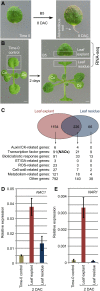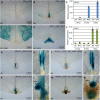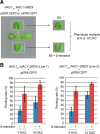Auxin-Independent NAC Pathway Acts in Response to Explant-Specific Wounding and Promotes Root Tip Emergence during de Novo Root Organogenesis in Arabidopsis
- PMID: 26850273
- PMCID: PMC4825153
- DOI: 10.1104/pp.15.01733
Auxin-Independent NAC Pathway Acts in Response to Explant-Specific Wounding and Promotes Root Tip Emergence during de Novo Root Organogenesis in Arabidopsis
Abstract
Plants have powerful regenerative abilities that allow them to recover from damage and survive in nature. De novo organogenesis is one type of plant regeneration in which adventitious roots and shoots are produced from wounded and detached organs. By studying de novo root organogenesis using leaf explants of Arabidopsis (Arabidopsis thaliana), we previously suggested that wounding is the first event that provides signals to trigger the whole regenerative process. However, our knowledge of the role of wounding in regeneration remains limited. In this study, we show that wounding not only triggers the auxin-mediated fate transition of regeneration-competent cells, but also induces the NAC pathway for root tip emergence. The NAC1 transcription factor gene was specifically expressed in response to wounding in the leaf explant, but not in the wounded leaf residue of the source plant. Inhibition of the NAC1 pathway severely affected the emergence of adventitious root tips. However, the NAC1 pathway functioned independently of auxin-mediated cell fate transition and regulates expression of CEP genes, which encode proteins that might have a role in degradation of extensin proteins in the cell wall. Overall, our results suggest that wounding has multiple roles in de novo root organogenesis and that NAC1 acts as one downstream branch in regulating the cellular environment for organ emergence.
© 2016 American Society of Plant Biologists. All Rights Reserved.
Figures








Similar articles
-
Transcription Factors WOX11/12 Directly Activate WOX5/7 to Promote Root Primordia Initiation and Organogenesis.Plant Physiol. 2016 Dec;172(4):2363-2373. doi: 10.1104/pp.16.01067. Epub 2016 Oct 26. Plant Physiol. 2016. PMID: 27784768 Free PMC article.
-
YUCCA-mediated auxin biogenesis is required for cell fate transition occurring during de novo root organogenesis in Arabidopsis.J Exp Bot. 2016 Jul;67(14):4273-84. doi: 10.1093/jxb/erw213. Epub 2016 Jun 2. J Exp Bot. 2016. PMID: 27255928 Free PMC article.
-
WOX11 and 12 are involved in the first-step cell fate transition during de novo root organogenesis in Arabidopsis.Plant Cell. 2014 Mar;26(3):1081-93. doi: 10.1105/tpc.114.122887. Epub 2014 Mar 18. Plant Cell. 2014. PMID: 24642937 Free PMC article.
-
De novo root regeneration from leaf explants: wounding, auxin, and cell fate transition.Curr Opin Plant Biol. 2018 Feb;41:39-45. doi: 10.1016/j.pbi.2017.08.004. Epub 2017 Dec 11. Curr Opin Plant Biol. 2018. PMID: 28865805 Review.
-
De novo root regeneration from leaf explant: a mechanistic review of key factors behind cell fate transition.Planta. 2025 Jan 14;261(2):33. doi: 10.1007/s00425-025-04616-1. Planta. 2025. PMID: 39808280 Review.
Cited by
-
NAC1 Maintains Root Meristem Activity by Repressing the Transcription of E2Fa in Arabidopsis.Int J Mol Sci. 2022 Oct 14;23(20):12258. doi: 10.3390/ijms232012258. Int J Mol Sci. 2022. PMID: 36293114 Free PMC article.
-
Pars Pro Toto: Every Single Cell Matters.Front Plant Sci. 2021 Jun 14;12:656825. doi: 10.3389/fpls.2021.656825. eCollection 2021. Front Plant Sci. 2021. PMID: 34194448 Free PMC article. Review.
-
Characterization of a vacuolar H+-ATPase G subunit gene from Juglans regia (JrVHAG1) involved in mannitol-induced osmotic stress tolerance.Plant Cell Rep. 2017 Mar;36(3):407-418. doi: 10.1007/s00299-016-2090-z. Epub 2016 Dec 16. Plant Cell Rep. 2017. PMID: 27986993
-
Tissue-Specific Metabolic Reprogramming during Wound-Induced Organ Formation in Tomato Hypocotyl Explants.Int J Mol Sci. 2021 Sep 18;22(18):10112. doi: 10.3390/ijms221810112. Int J Mol Sci. 2021. PMID: 34576275 Free PMC article.
-
Transcriptome Reveals the Regulation of Exogenous Auxin Inducing Rooting of Non-Rooting Callus of Tea Cuttings.Int J Mol Sci. 2024 Jul 24;25(15):8080. doi: 10.3390/ijms25158080. Int J Mol Sci. 2024. PMID: 39125650 Free PMC article.
References
-
- Asahina M, Azuma K, Pitaksaringkarn W, Yamazaki T, Mitsuda N, Ohme-Takagi M, Yamaguchi S, Kamiya Y, Okada K, Nishimura T, et al. (2011) Spatially selective hormonal control of RAP2.6L and ANAC071 transcription factors involved in tissue reunion in Arabidopsis. Proc Natl Acad Sci USA 108: 16128–16132 - PMC - PubMed
-
- Bostock RM. (1989) Perspectives on wound healing in resistance to pathogens. Annu Rev Phytopathol 27: 343–371
Publication types
MeSH terms
Substances
LinkOut - more resources
Full Text Sources
Other Literature Sources
Molecular Biology Databases

